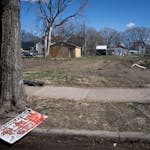The Minneapolis Park Board has signaled it may pass a major redesign of the Hiawatha Golf Course that previous commissioners had rebuffed twice.
The board's Planning Committee unanimously voted to resurrect the park staff's $43 million Hiawatha Golf Course Master Plan on Wednesday night. It still faces a public hearing and a full vote by the board.
The draft plan is designed to remediate flooding, groundwater pumping and financial losses at Hiawatha by restyling the 18-hole standard golf course into a nine-hole executive course.
A channel carving through the low-lying site would allow floodwater to flow into Lake Hiawatha, mimicking how water once moved through the Minnehaha Creek floodplain before the Park Board dredged a naturally occurring wild rice lake in 1923 to create the golf course.
The plan includes a clubhouse named for Black golf legend Solomon Hughes, a learning center for new players, a small restaurant, dog patio and lake house with kayak rentals.
"The solution is right before us," said committee co-chair Becky Alper, who made an election promise to resurrect the resolution.
"It's one that we have collectively — the Park Board, its staff, park goers, park commissioners — have dedicated the past eight years to, is one of compromise, where everyone is heard, including golfers, neighbors, environmental stewards, children, seniors."
Joining Alper on the committee are co-chair Cathy Abene and Commissioners Tom Olsen, Elizabeth Shaffer and Alicia D. Smith.
Hiawatha's water problems date back to the 2014 flood, which closed half the course for more than a year. Rainfall overwhelmed the pumping system and made a bathtub of the course. Hundreds of trees died. The total cost of that flood was estimated at $4 million, and the Federal Emergency Management Agency had to bail out the Park Board.
That flood was a 10-year storm event, meaning there is a 1 in 10 chance of the golf course flooding each year, said Michael Schroeder, the board's assistant superintendent of planning.
As park staff later looked to address flooding, they discovered the amount of groundwater being pumped off the course into Lake Hiawatha dry was more than the water needs of a small Minnesota town. The Park Board pumps up to 400 million gallons per year.
More than a dozen people addressed the plan at Wednesday's meeting. The majority, including volunteers who have scooped 10,000 pounds of plastic out of Lake Hiawatha and environmentalists concerned about the amount of phosphorous runoff from golf course fertilizers, were in favor of the redesign.
Opponents included neighbors who fear that, despite Park Board promises to protect nearby homes from flooding during re-construction, they would lose the benefit of golf course pumping currently keeping their basements dry.
Black golfers advocating for the preservation of Hiawatha's 18 holes did not participate. However, Bronze Foundation President Darwin Dean, Martha Arradondo of Black Women on Course and others appealed to park commissioners during a board retreat earlier this month. They spoke of the golf course's history of pioneering integration and providing unlikely refuge and success stories for Black golfers discriminated against elsewhere.
Golfer Henry Crosby of Golden Valley asked commissioners to consider how the planners managed to blast highways through Black communities but can't make an 18-hole course flood-resilient. He described how their group of 50 or so Black golfers are treated with unease when they play outside their home turf of Hiawatha.
An alternate plan?
Park Board President Meg Forney, who has consistently voted to support park staff's nine-hole redesign, invited the Bronze Foundation and its golf course designer partners to present a newly created "alternate plan" at the board's April 6 meeting.
The basic concept of the alternate plan was created by Pacific Advanced Civil Engineering's Andy Komor, a University of Minnesota graduate. It includes:
- Naturalized channels would direct watershed flows around the entire golf course before converging at the southeast corner of Lake Hiawatha and continuing to the Mississippi River.
- Surface level of Lake Hiawatha would be drawn down, with one-third of the lake used to create the channels and keep their water levels high enough to push adequate flow downstream.
- The remaining two-thirds would be drained by 60 acre-feet, or about 20 million gallons, in order to create wetlands and catch floodwaters that may otherwise inundate the golf course.
"Our company's tagline is, 'In partnership with nature,'" Komor said. "And we've done hundreds of projects where we actually make it more natural."
Commissioner Olsen, who ran for election on the promise to pass the Hiawatha Golf Course Master Plan, dismissed the idea as "ludicrous," predicting it would bring "environmental catastrophe."
"My whole life, my modus operandi has been devoted to improving our natural environment and fighting for our climate and fighting for our futures, and frankly, golf is in many ways antithetical to that goal," he said. "So if we were going to hear, and give extra attention to an 18-hole plan, why don't we hear a plan for no golf?"
Discussions to continue
Commissioner Becka Thompson, who represents north Minneapolis but does not sit on the Planning Committee, defended the Black golfers' point of view.
"Do our values go beyond our yard signs of what it means to really listen, what it really means to engage in communities that have been traditionally marginalized?" she asked.
She reminded the board that their predecessors had repeatedly rejected the Hiawatha Golf Course Master Plan and that taking it up again so early in the new board's term felt like a "slap in the face" to her constituents.
Commissioners Shaffer, Forney and Billy Menz, who also does not sit on the Planning Committee, urged the board to listen to communities with different priorities for parks.
"I will continue to be challenged until we take a vote because we keep, in our society and in our city and in our country, we're consistently pitting environmental action against racial equity," Menz said. "It is not easy, but I would welcome more planning."
Park staff did not disclose their stand on the Komor alternate plan, but Schroeder said they would offer their analysis at the board's April 20 meeting, when there will be a public hearing on the topic before the Planning Committee.




